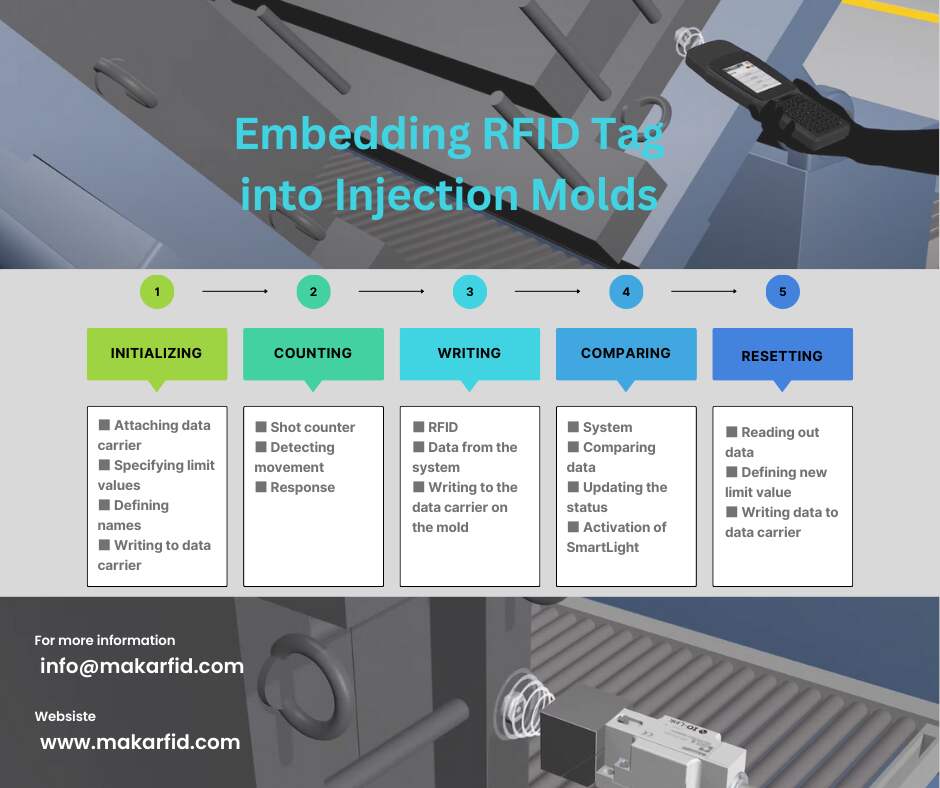RFID Tech Boosts Electroplating Efficiency & Safety
Have you ever considered who uses RFID technology in electroplating production lines and why? This technology boosts automation, enhancing the accuracy and reliability of data collection and streamlining the production process. With RFID tags on products and equipment, users can track and monitor item movements throughout the production process.
This technology enables real-time data collection, inventory management, and quality control. These advancements lead to cost savings and increased productivity. Numerous industries, including automotive, aerospace, and electronics, have integrated RFID technology into their electroplating production lines to improve their manufacturing processes.

Radio Frequency Identification (RFID) is an advanced wireless communication technology that can identify specific targets and read related data through electromagnetic fields or radio frequencies, a process that requires no mechanical or optical contact. The applications of RFID technology are very extensive, from product tracking in the retail industry, to automated toll systems in the transportation field, to various aspects of industrial production. In recent years, the application of RFID technology in the electroplating industry has become increasingly widespread, and its role in this field is becoming increasingly important.
Electroplating is a common and important metal surface treatment technology that deposits a thin film on the metal surface through electrolysis to improve the corrosion resistance, wear resistance, appearance, or other properties of the metal. In the production process, the electroplating industry needs to precisely control many parameters, such as current, voltage, time, temperature, and chemical composition, to ensure the quality and consistency of the products. However, due to the harsh conditions in the production environment, such as large amounts of dust, high temperature and humidity, and corrosion, traditional barcodes and QR codes have many limitations in actual production, such as causing inability to read or read errors.
Compared to traditional barcodes and QR codes, RFID technology has many significant advantages, such as long reading distance, ability to be used in harsh environments, no need for tag visibility during identification, updateable tag content, ability to identify moving objects at high speed, and large data storage space.
Therefore, adopting RFID technology can achieve data collection on the electroplating production line, and when combined with existing equipment, can significantly enhance automation levels and improve the accuracy and reliability of data collection on the electroplating production line. This can not only greatly improve production efficiency and material utilization rate, but also effectively reduce the rate of defective products, thus ensuring product quality while improving production efficiency.
RFID technology plays an indispensable role in the tracking management of electroplated workpieces.
Once the workpieces are tagged with RFID, we can record and store various information about the workpieces, including type, specifications, pre-plating processing procedures, and plating parameters, etc. By using RFID readers, we can quickly read and update this information, thereby tracking and managing workpieces in real time. This method not only effectively reduces manual errors, but also helps us quickly locate problems, thereby improving production efficiency and product quality.
RFID technology also plays an important role in optimizing material management of electroplating production lines.
We can install RFID tags on raw materials, chemical reagents, and equipment to achieve automatic identification and management of inventory. Based on the consumption of materials, we can achieve automatic replenishment of materials, avoiding production interruptions or resource waste caused by material shortages or excesses.
RFID technology also plays an important role in the quality control of electroplating.
By connecting the RFID system with production equipment, we can monitor key parameters in the electroplating process in real time, such as current density, solution temperature, and pH value, etc. Once these parameters deviate from the set range, the system will immediately sound an alarm and automatically adjust the equipment to ensure the stability of the electroplating process, thereby ensuring the consistency and high quality of products.
RFID technology also plays an important role in improving the safety of the electroplating industry.
In the electroplating workshop, we can monitor the location and health status of workers in real time through RFID technology. In case of an emergency, we can quickly take responsive measures, thereby effectively reducing the risk of accidents.



The application of RFID technology in electroplating hangers involves several important links, which include the initialization of hanger tags, recognition of hanger tags, workflow management, and logistics management. Detailed introductions to these links are as follows:
- Initialization of hanger tags: In this initial stage, the electroplating factory binds each hanger with an RFID electronic tag with a unique code. In this way, all parts on each hanger are associated with a specific RFID tag, ensuring that they can be correctly tracked and identified throughout the electroplating process. This method provides a very effective way to track and manage each individual hanger and part.
- Recognition of hanger tags: When the parts are hung on the hanger and enter the electroplating line, the RFID reader will automatically recognize all the hanger information entering the spraying process. This information is then uploaded to the control system, which can count the use times of the hanger based on this information and provide maintenance or scrapping prompts. At the same time, the system will also pass on the identified types of parts and process information to relevant process equipment to ensure the correctness of operation. This step is key to ensuring accuracy and efficiency in the production process.
- Workflow management: When the hanger with an RFID electronic tag enters the work area, the RFID reader will automatically recognize the hanger tags within the work range, obtain tag information in real time, and pass this information to relevant process equipment. This process ensures the completeness of the production process and helps supervise the production process and technology of plating products, thereby improving the standardization and informatization level of product management. In this way, more efficient production process management can be achieved, thereby improving production efficiency and product quality.
- Logistics management: As a large number of chemicals are used in the electroplating production process, these chemicals all pose potential environmental and safety risks. Therefore, logistics management is particularly important in the electroplating industry. RFID technology is used to monitor the location, quality, packaging, and other information of chemicals in real time online, ensuring that the entire process from the production of chemicals to transportation, storage, and use can be traced. In this way, any process that has not been confirmed by reading the RFID reader cannot pass through the corresponding pass, so RFID can not only improve logistics efficiency but also significantly improve safety.
Through the above applications, RFID technology has enhanced efficiency, safety, and traceability in the electroplating industry, becoming an indispensable part of modern electroplating production management. These advantages of RFID technology have made its application in the electroplating industry more and more widespread.
In general, the application of RFID radio frequency identification technology in the electroplating industry provides effective solutions for improving production efficiency, ensuring product quality, optimizing material management, and enhancing safety. With the continuous advancement of technology and the reduction of costs, it is expected that RFID will be more widely used in the electroplating industry.


